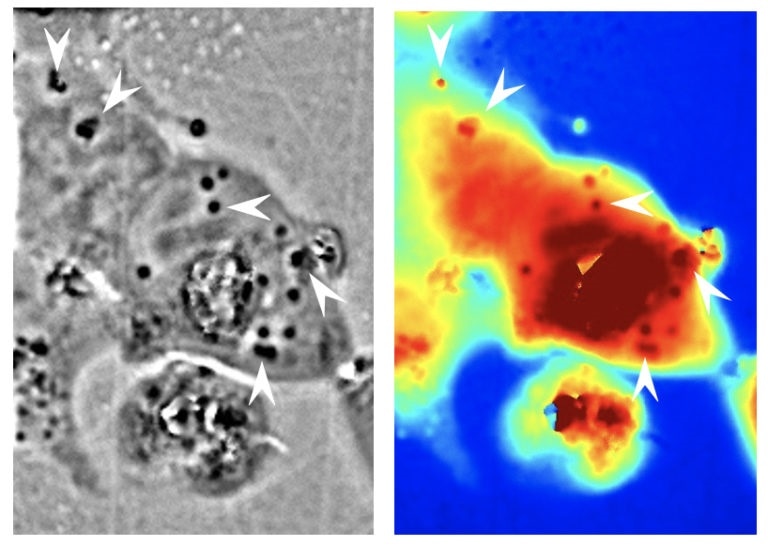Sea creatures, including squids and octopuses, can perform a disappearing act by employing unique tissues in their bodies to exploit the reflection and transmission of light. Scientists from the University of California, Irvine have now engineered human cells that have analogous transparent abilities.

The black and white phase microscope image above helped UCI researchers identify where the squid reflectin protein nanostructures were present in human cells (dark regions, with some indicated by white arrows). The panel in color shows the associated pathlength for light traveling through a given area (red corresponds to longer pathlengths and blue corresponds to shorter pathlengths). Image Credit: Atouli Chatterjee/University of California, Irvine.
The researchers explained that they drew their inspiration from cephalopod skin to impart tunable transparency and light-scattering properties to the mammalian cells. The study was recently published in the Nature Communications journal.
For millennia, people have been fascinated by transparency and invisibility, which has inspired philosophical speculation, works of science fiction, and much academic research.”
Atrouli Chatterjee, Study Lead Author and Doctoral Student, Department of Chemical and Biomolecular Engineering, University of California, Irvine
Chatterjee continued, “Our project—which is decidedly in the realm of science—centers on designing and engineering cellular systems and tissues with controllable properties for transmitting, reflecting and absorbing light.”
Chatterjee works in the lab of Alon Gorodetsky, an Associate Professor of Chemical & Biomolecular Engineering at the University of California, Irvine, who has a long record of studying how the color-changing capabilities of cephalopods can be imitated to develop special technologies to help people.
The bio-inspired research conducted by Chatterjee’s team has resulted in innovative developments in infrared camouflage and other sophisticated materials.
In this work, the team was inspired by the way female Doryteuthis opalescens squids escape predators by dynamically changing a stripe on their mantle from almost transparent to opaque white.
Then, borrowing certain intercellular protein-based particles that play a role in this biological cloaking strategy, the researchers discovered a way to introduce them into the human cells to verify whether the light-scattering properties could also be transferred to other types of animals.
Leucophores are specialized reflective cells present in this species of squids. These cells can change the way they scatter light. They also contain leucosomes, which are membrane-bound particles made up of proteins called reflectins. These reflectins can create iridescent camouflage.
To express reflectin, the scientists grew human embryonic kidney cells and genetically engineered them during their experiments. They observed that the protein would assemble into particles in the cytoplasm of the cells in a random manner.
Through optical microscopy and spectroscopy, the researchers also observed that the introduced reflectin-based structures induced the cells to alter their light-scattering properties.
We were amazed to find that the cells not only expressed reflectin but also packaged the protein in spheroidal nanostructures and distributed them throughout the cells’ bodies.”
Alon Gorodetsky, Study Co-Author and Associate Professor, Department of Chemical and Biomolecular Engineering University of California, Irvine
Gorodetsky continued, “Through quantitative phase microscopy, we were able to determine that the protein structures had different optical characteristics when compared to the cytoplasm inside the cells; in other words, they optically behaved almost as they do in their native cephalopod leucophores.”
In another significant part of the research, the scientists verified whether it was possible to toggle the reflectance on and off via external stimuli. They closely packed the cells in between the coated glass plates and introduced varying concentrations of sodium chloride.
When the researchers quantified the amount of light transmitted by the cells, they discovered that the ones subjected to higher sodium levels scattered more amounts of light and also stood out more from the surroundings.
Our experiments showed that these effects appeared in the engineered cells but not in cells that lacked the reflectin particles, demonstrating a potential valuable method for tuning light-scattering properties in human cells.”
Atrouli Chatterjee, Study Lead Author and Doctoral Student, Department of Chemical and Biomolecular Engineering, University of California, Irvine
While imperceptible humans continue to be firmly engrossed in the world of science fiction, the study performed by his research group can provide some real benefits in the near future, added Gorodetsky.
“This project showed that it’s possible to develop human cells with stimuli-responsive optical properties inspired by leucophores in celphalopods, and it shows that these amazing reflectin proteins can maintain their properties in foreign cellular environments,” added Chatterjee.
This latest knowledge could also present new possibilities to use reflectins as a novel type of biomolecular marker for medical as well as biological microscopy applications, concluded Chatterjee.
Source:
Journal reference:
Chatterjee, A., et al. (2020) Cephalopod-inspired optical engineering of human cells. Nature Communications. doi.org/10.1038/s41467-020-16151-6.